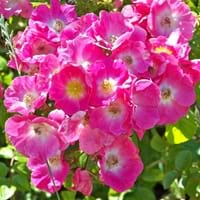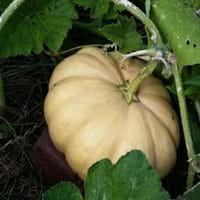Life Span
Annual and Perennial
Annual and Perennial
Type
Perennial
Vegetable, Vines
Origin
Hybrid origin
North America, Mexico, Central America
Types
it is a type of rose
Winter squash, Field pumpkin, Crookneck pumpkin
Habitat
Not Available
close to waterfalls, Riverbanks, Warmer regions, waterways, Wet ground
USDA Hardiness Zone
5-8
1-6
Sunset Zone
A1, A2, A3, H1, H2, 1a, 1b, 2a, 2b, 3a, 3b, 4, 5, 6, 7, 8, 9, 10, 11, 12, 13, 14, 15, 16, 17, 18, 19, 20, 21, 22, 23, 24
A1, A2, A3, H1, H2, 1a, 1b, 2a, 2b, 3a, 3b, 4, 5, 6, 7, 8, 9, 10, 11, 12, 13, 14, 15, 16, 17, 18, 19, 20, 21, 22, 23, 24
Habit
Vining/Climbing
Vining/Climbing
Minimum Width
Not Available
Flower Color
White, Pink
Yellow
Flower Color Modifier
Not Available
Bicolor
Fruit Color
Non Fruiting Plant
Orange Red, Yellow Brown
Leaf Color in Spring
Dark Green
Green, Light Green
Leaf Color in Summer
Dark Green
Green, Dark Green
Leaf Color in Fall
Dark Green
Green, Dark Green
Leaf Color in Winter
Light Green
Not Available
Leaf Shape
Oval
Heart-shaped
Plant Season
Summer
Early Winter
Sunlight
Full Sun, Partial Sun
Full Sun
Growth Rate
Medium
Very Fast
Type of Soil
Loam, Sand
Well drained
The pH of Soil
Acidic, Neutral
Neutral
Soil Drainage
Well drained
Well drained
Bloom Time
Summer, Late Summer
Summer
Tolerances
Drought
Drought
Where to Plant?
Container, Ground, Pot
Ground
How to Plant?
Divison, Seedlings
Seedlings
Plant Maintenance
Medium
Medium
Watering Requirements
Water Deeply, Water in morning to avoid prompting diseases
Keep the ground moist but not water-logged, Requires regular watering, Requires watering in the growing season
In Summer
Lots of watering
Lots of watering
In Spring
Moderate
Moderate
In Winter
Average Water
Average Water
Soil pH
Acidic, Neutral
Neutral
Soil Type
Loam, Sand
Loam
Soil Drainage Capacity
Well drained
Well drained
Sun Exposure
Full Sun, Partial Sun
Full Sun
Pruning
Prune after flowering, Remove damaged leaves, Remove dead branches
prune leaves so as to circulate fresh air, Remove Vines
Fertilizers
Fast release fertilizer, Fertilize in early spring, Fertilize three times a year
Apply 5-10-5 amounts, Nitrogen, Phosphorous, Potassium
Pests and Diseases
Aphids, Black Spot, Caterpillars, Downy mildew, glasshouse red spider mite, Insects, Leaf Hoppers, Powdery mildew, rose leaf-rolling sawfly, Rust, Scale
Gray leaf blight, Scab
Plant Tolerance
Drought
Salt and Soil Compaction
Flower Petal Number
Single
Single
Foliage Texture
Medium
Coarse
Foliage Sheen
Glossy
Matte
Attracts
Not Available
Beetles, Bugs
Allergy
Not Available
Asthma, breathing problems, Itchiness, Swelling in the face
Aesthetic Uses
Showy Purposes, Used for decorating walls, fences, gates, hedges, etc.
Not Used For Aesthetic Purpose
Beauty Benefits
Perfumes
Good for skin and hair, Skin cleanser, Skin Problems
Environmental Uses
Air purification
Air purification
Medicinal Uses
No Medicinal Use
Anemia, Antibacterial, anti-cancer, cholesterol-lowering, High blood pressure, Immunity, Prevention of convulsion, Regulates Blood Sugar
Part of Plant Used
Flowers, Whole plant
Fruits, Leaves, Seeds
Other Uses
Used as Ornamental plant
Used As Food, Used as Ornamental plant, Used for its medicinal properties, Used in salads
Used As Indoor Plant
Yes
Yes
Used As Outdoor Plant
Yes
Yes
Garden Design
Cutflower, Feature Plant, Groundcover, Hedges, Mixed Border, Rock Garden / Wall, Topiary / Bonsai / Espalier, Vine
Edible, Herb / Vegetable, Vine
Botanical Name
ROSA 'American Pillar'
CUCURBITA moschata 'Long Island Cheese'
Common Name
Climbing Rose, Rambling Rose
Long Island Cheese Pumpkin, Winter Pumpkin
In Hindi
Climbing Rose
चीनी कद्दू
In German
Kletterrose
chinesisch Kürbis
In French
escalade Rose
potiron chinois
In Spanish
Rose que sube
calabaza china
In Greek
αναρρίχηση Rose
κινέζικο κολοκύθα
In Portuguese
Rosa de escalada
abóbora chinês
In Polish
Climbing Rose
Chiński dyni
In Latin
Rosa scandere
Chinese cucurbita
Phylum
Magnoliophyta
Magnoliophyta
Class
Magnoliopsida
Magnoliopsida
Family
Rosaceae
Cucurbitaceae
Clade
Not Available
Angiosperms, Eudicots, Rosids
Tribe
Not Available
Cucurbiteae
Subfamily
Not Available
Cucurbitoideae
Number of Species
Not Available
Importance of Climbing Rose and Cheese Pumpkin
Want to have the most appropriate plant for your garden? You might want to know the importance of Climbing Rose and Cheese Pumpkin. Basically, these two plants vary in many aspects. Compare Climbing Rose and Cheese Pumpkin as they differ in many characteristics such as their life, care, benefits, facts, etc. Every gardener must at least have the slightest clue about the plants he wants to plant in his garden. Compare their benefits, which differ in many ways like facts and uses. The medicinal use of Climbing Rose is No Medicinal Use whereas of Cheese Pumpkin is Anemia, Antibacterial, anti-cancer, cholesterol-lowering, High blood pressure, Immunity, Prevention of convulsion and Regulates Blood Sugar. Climbing Rose has beauty benefits as follows: Perfumes while Cheese Pumpkin has beauty benefits as follows: Perfumes.
Compare Facts of Climbing Rose vs Cheese Pumpkin
How to choose the best garden plant for your garden depending upon its facts? Here garden plant comparison will help you to solve this query. Compare the facts of Climbing Rose vs Cheese Pumpkin and know which one to choose. As garden plants have benefits and other uses, allergy is also a major drawback of plants for some people. Allergic reactions of Climbing Rose are Not Available whereas of Cheese Pumpkin have Asthma, breathing problems, Itchiness and Swelling in the face respectively. Having a fruit bearing plant in your garden can be a plus point of your garden. Climbing Rose has showy fruits and Cheese Pumpkin has showy fruits. Also Climbing Rose is not flowering and Cheese Pumpkin is not flowering . You can compare Climbing Rose and Cheese Pumpkin facts and facts of other plants too.





